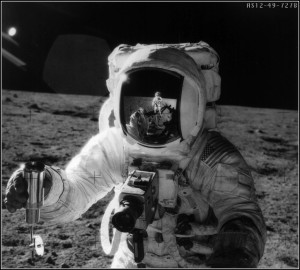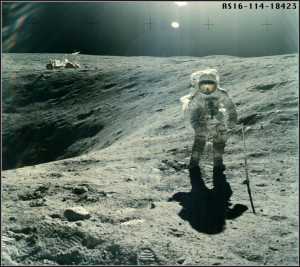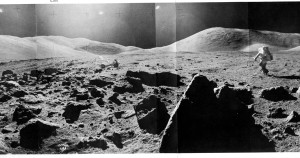Images from Apollo
Click images to enlarge
My photography has more to do with America’s moon landing program than just about anything else.
As a baby boomer I watched the succession of American manned space flights, from the first sub-orbital flight of Alan Shepard, leading up to the Apollo moon landings that President Kennedy had challenged the nation to complete. I fully expected to be part of the second generation of lunar explorers who would colonize, geologically map and set up scientific instruments on the moon. But as it turned out, America’s interest in the moon was superficial and short lived.
Between 1969 and 1972, 12 men left boot prints on the lunar surface as part of the Apollo moon landing program.
It turned out to be more of a cold-war PR competition than an actual scientific effort but NASA did what it could to get some real science done in between posing with the American flag.
I was 16 when Neil Armstrong put the first footprint on the moon and 19 when Eugene Cernan left the last. But in those three years some absolutely breathtaking images came back.
As you can see from the photo above, the astronauts were equipped with fine gear. A Hasselblad camera protruded in front of them. The camera was an excellent choice both for its durability in the temperature extremes of the lunar surface, and for its ability to capture superior images, all shot by astronauts wearing space suits and gloves.
Since so much of my landscape photography has its roots in Apollo era images, particularly the mosaic-like panoramic images, I thought it might be worthwhile sharing some of my favorite images from the moon.
My favorites tend to cluster more toward the later missions when we visited epic lunar geological features, and when the rovers expanded the range of mobility of astronauts considerably.
But there are certain favorites from the early missions as well.
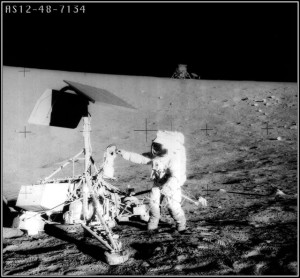 Apollo 11 was the first manned moon landing, but Apollo 12 was the first truly interesting lunar mission. It landed within a few hundred yards of the Surveyor robot spacecraft, which tested the possibility of landing on the moon a few years earlier.
Apollo 11 was the first manned moon landing, but Apollo 12 was the first truly interesting lunar mission. It landed within a few hundred yards of the Surveyor robot spacecraft, which tested the possibility of landing on the moon a few years earlier.
The astronauts snipped bits of metal and tubing from the Surveyor spacecraft and returned them to earth in order to study what the general flux of micrometeorites was, and how we could best design materials to withstand that bombardment if and when we ever colonize the moon. It also gave a pretty good indication of how the solar wind might imact spacecraft at an essential point when the International Space Station was being designed.
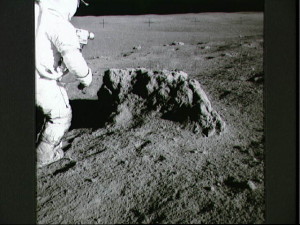 Apollo 13 suffered an explosion on its way out to the moon but managed to return the crew to the earth, thanks to some engineering wizardry on the ground. Its landing site was given to the crew of Apollo 14. Though still pretty flat land, the spacecraft touched down in the vicinity of some pretty good sized boulders.
Apollo 13 suffered an explosion on its way out to the moon but managed to return the crew to the earth, thanks to some engineering wizardry on the ground. Its landing site was given to the crew of Apollo 14. Though still pretty flat land, the spacecraft touched down in the vicinity of some pretty good sized boulders.
Apollo 15 through 17 all went to much more adventurous sites and had lunar buggies to drive around with. this expanded both the radius and the duration of the moon walks, which often stretched out to over six hours at a shot.
With Apollo 15 panoramas that show the horizon start to become more common. We see the scale of the landing area and the type of terrain visited, as well as the equipment used to travel around.
0Apollo 16 visited another more complex terrain in search of materials from the lunar highlands. At all of the sites since the beginning a variety of geophisical experiments were set up. But Apollo 16 also had a small solar observatory that it left in the shade of the rover.
The final moon mission was the first to actually land a geologist on the lunar surface. Harrison “Jack” Schmitt joined commander Eugene Cernan on what would prove to be the most ambitious EVA (Extravehicular Activity, or “moon walk”) of the Apollo era.
 Probably more than any other mission its returned images showed more of the ruggedness and variety of terrain this landing site offered, as well as how busy the astronauts were on their multiple EVAs spread over several days.
Probably more than any other mission its returned images showed more of the ruggedness and variety of terrain this landing site offered, as well as how busy the astronauts were on their multiple EVAs spread over several days.
Their panoramas show rolling hills and gigantic boulders, the gray lunar surface and the jet black sky of space.
It’s easy to understand how such other worldly images might become a source of inspiration to a photographer on earth who lives in rather rugged terrain, filled with exotic desert plants and animals.
And so these Apollo images have become a kind of touchstone in my work, both for my panoramic photography and the moon-like effects I try to bring to my gray scale imagery.
Here are a few examples of each.
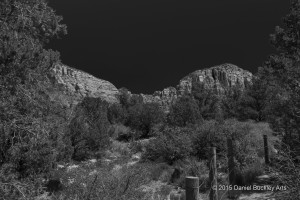 From the grayscale group here is a shot taken in Sedona, Arizona on a cloudless day of deep blue sky. In this photo the saturation of the blue sky has been reduced to zero to simulate the black sky of the moon, and also to suggest that this might have been taken at night in moonlight. In fact it was shot in broad daylight.
From the grayscale group here is a shot taken in Sedona, Arizona on a cloudless day of deep blue sky. In this photo the saturation of the blue sky has been reduced to zero to simulate the black sky of the moon, and also to suggest that this might have been taken at night in moonlight. In fact it was shot in broad daylight.
As an example of the panoramic work, here is another Sedona landscape, showing close to 180 degrees of the horizon.
 I often find myself returning to Apollo imagery for inspiration, and now find myself viewing the world around me with a very different perspective. This is becoming more pronounced as I work with models and try to achieve a very unreal sense of place as I photograph them in the desert.
I often find myself returning to Apollo imagery for inspiration, and now find myself viewing the world around me with a very different perspective. This is becoming more pronounced as I work with models and try to achieve a very unreal sense of place as I photograph them in the desert.
The first is the proverbial posing with the flag on the moon, this shot from Apollo 16.
The second is a flag waving over a junkyard in South Tucson, Arizona, presented in grayscale with the blue sky diminished to black.
 I saw it and it make me think again of the moon. One of these days I’ll take the time to mask the flag and present it full color against the black background. But for now, good enough.
I saw it and it make me think again of the moon. One of these days I’ll take the time to mask the flag and present it full color against the black background. But for now, good enough.

